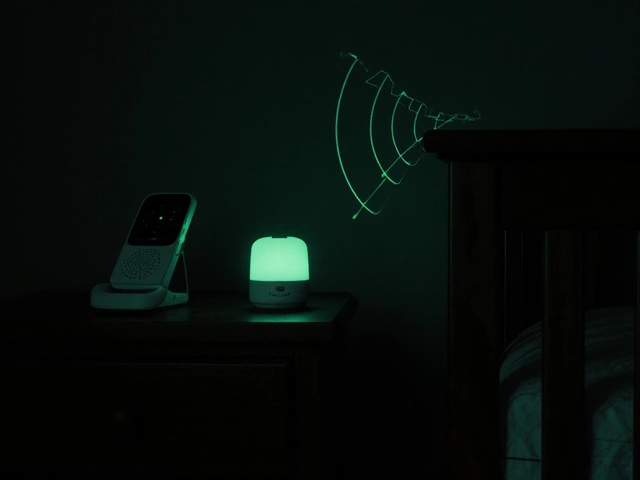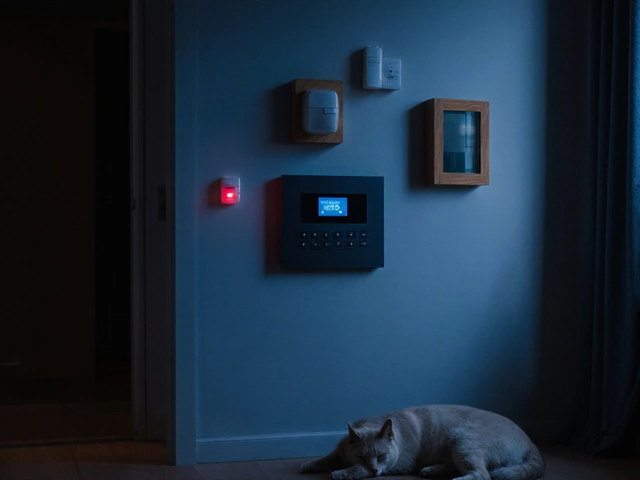Ever get that nagging feeling you forgot to lock the door or left a window open when you’re halfway to work? Smart home security promises you’ll never have to drive back and check again. You can peek at live camera feeds, lock doors, or even yell at the dog through a speaker, all from your phone. That sounds great, but is it really as smooth as it looks in commercials?
The big draw with smart security isn’t just cool gadgets—it’s about getting peace of mind without breaking your routine. Most systems put you in control, letting you keep tabs on packages, pets, or unexpected visitors in real time. And if you’re the type who hands out spare keys like candy, a smart lock means you don’t lose sleep when your kid’s friend forgets to return one.
But here’s the thing: Upfront, it’s easy to get pulled in by the hype. Brands toss out buzzwords like ‘AI-powered’ or ‘seamless integration’. What you actually care about—is your stuff safe, is it easy to use, and do you end up spending more time fixing glitches than you save with all this tech? Let’s get into what these setups truly offer, both the perks and the headaches.
- What Makes a Home 'Smart'?
- Everyday Life with a Smart Security System
- The Real Costs—Money, Time, and Headaches
- Is a Smart House Right for You?
What Makes a Home 'Smart'?
So, what takes a regular house and bumps it up to the level of a smart house? At its core, it’s about hooking up your home with devices that talk to each other and to you. We’re talking about stuff like security cameras you can view on your phone, smart locks you control remotely, and sensors that send an alert if something’s off while you’re out.
A true smart home system pulls these pieces together for easy control—usually from a single app or sometimes by just talking to your smart speaker. Some key gear you’ll see in most setups includes:
- Video doorbells that let you see and talk to whoever’s at your door, even when you’re not home.
- Motion sensors that pick up movement and send alerts right to your phone.
- Smart locks that can lock or unlock with an app, keycode, or even your voice.
- Wireless cameras with night vision, so you’re not relying on grainy footage from ten years ago.
- Window and door sensors, which are basically tiny alarms if someone tries to sneak in.
The difference between all-in-one smart systems and DIY gadgets is how well they play together. If you buy stuff piece by piece, you might end up with five different apps and a lot of frustration. Getting a system where your smart house devices work as a team is the secret to making the tech actually useful. Look for brands that support things like Google Home, Alexa, or Apple HomeKit—those are the big players that pull all your devices under one roof.
One overlooked fact: Smart homes aren’t just for new houses or hardcore tech geeks. Most gear these days runs on Wi-Fi or Bluetooth and needs nothing but a screwdriver. So, if you can set up a router, you can probably handle a smart home starter kit.
Everyday Life with a Smart Security System
If you’ve never actually lived with a smart house security setup, you might think it’s just for folks who want to show off. But for lots of people, these systems are about making life less stressful, not more complicated. You don’t have to turn your living room into a tech showroom to get some real benefits.
Imagine it’s 10PM and you’re already in bed when you hear a strange noise outside. Instead of stumbling around in the dark, you just tap your phone, check the front door camera, and decide if it’s just a raccoon or something worth worrying about. If you have kids, there’s something nice about getting a phone alert when they get home from school—no guessing if they made it in safely. And if you get a lot of deliveries, smart doorbells let you talk to the driver, so packages don’t just walk off.
Here’s what using smart security looks like during a regular week:
- Your system sends a reminder if you left your garage open—way better than the old sticky notes on the dashboard.
- Motion sensors light up the path when you walk in late, so you don’t trip over shoes in the dark.
- Going on vacation? Most systems let you set up routines that make lights go on and off, so it actually looks like someone’s home. Plus, your phone tells you instantly if a window pops open or—worse—your basement starts flooding.
According to research from Parks Associates in 2024, over 30% of new homebuyers look for smart security features specifically, and households with kids are 40% more likely to use connected cameras or smart locks compared to those without.
| Feature | Usage Rate (US Homes, 2024) |
|---|---|
| Smart Cameras | 24% |
| Smart Locks | 19% |
| Video Doorbells | 28% |
| Smart Alarms/Sensors | 22% |
So, these gadgets aren’t just for tech geeks—they’re sliding into regular homes fast. If you set up alerts right, there’s less chance of missing real problems. Just remember, most systems will ping your phone for every motion—set your zones carefully or you’ll eventually ignore the useful alerts along with the false ones. The bottom line: for daily peace of mind, smart security makes things a lot simpler, as long as you actually use the features that fit your lifestyle.

The Real Costs—Money, Time, and Headaches
Turning your regular place into a smart house isn’t just plug-and-play. There are real costs and not just the price tag on the box. It stacks up quick, and sometimes it’s not what you expect.
Let’s talk numbers first, because that’s where most folks get surprised. A basic starter security setup—which usually means a couple cameras, a smart lock, and maybe a door sensor—runs from $200 to $500. Want more cameras, window sensors, or coverage for the backyard? That bill can jump above $1,000, easy. And most big-name brands offer monthly subscriptions if you want remote access, cloud storage for video, or 24/7 monitoring. These range from $5 to as high as $40 a month, depending on how fancy you go.
| Item | Upfront Cost | Ongoing Cost (per month) |
|---|---|---|
| Starter Bundle (2 cams, lock, sensors) | $200–$500 | $0–$15 |
| Expanded Security (8+ sensors, doorbell, cameras) | $800–$1,500 | $20–$40 |
| Professional Install | $100–$300 (one-time) | - |
Then there's the time stuff, which nobody puts on the box. Plan to spend a few hours on setup—unless you shell out for pro installation. Apps can be fussy and firmware updates pop up every month or so. Some devices don’t talk to others (yep, even if they act like they should), and it takes extra fiddling to get schedules, automations, and user access right. If you’ve got roommates or a busy family, everyone needs to learn how to use the system, or you wind up getting constant “alarm accidentally triggered” texts.
Don’t forget headaches when things don’t work. Batteries die. WiFi drops. Sometimes you’re staring at an app spinning for five minutes and the camera won’t load. Privacy issues come up if you sync your data to the cloud. Brands like Ring and Google Nest have made headlines because of data breaches or sharing video with law enforcement—usually buried deep in the terms nobody reads.
- Choose brands that commit to regular security updates.
- Set calendar reminders to swap batteries every 6–12 months.
- Double-check if your WiFi can handle smart devices before buying—weak signal means shaky protection.
There’s peace of mind, but you pay in more ways than cash. Be ready for some trial and error, and maybe a few family group chats about who triggered the alarm—again.
Is a Smart House Right for You?
If you’re still on the fence, answer this: do you want more control and insight into what happens at home, or does all the tech worry you about headaches down the line? Let’s break down who gets the most out of a smart house and who might want to hold off.
If you’re always away (think: frequent traveler, crazy work schedule, busy parents), remote monitoring and quick alerts can be worth their weight. Add in a press release from Statista showing that 33% of US households with broadband now own a smart home device, and you’re far from alone in stepping into high-tech territory.
- Peace of mind: Real-time notifications mean you know right away if someone’s at your door when you’re not home, or if a smoke alarm trips.
- Convenience and control: Smart security lets you open the door for dog walkers or family from your work desk or while you’re on a beach. No more racing home to beat a guest or service worker.
- Energy and cost savings: Some systems tie into thermostats or smart lighting, trimming your bills over time. Even a single device like a smart thermostat averages $131 in annual savings, according to the US Department of Energy.
- Integration with existing stuff: If you already love Alexa or Google Assistant, adding smart security is often plug-and-play. Just watch for compatibility headaches if you’re mixing brands.
Still, a smart home isn’t for everyone. If you’re not a fan of constant updates, tech troubleshooting, or “cloud” anything, think twice. Power outages and Wi-Fi drops can make things flaky. Plus, you’re trusting your home’s safety to the same cloud that sometimes forgets your passwords.
| Consideration | Smart House | Traditional Security |
|---|---|---|
| Remote control | App/Voice control from anywhere | Usually local only |
| Maintenance | Software & device updates | Basic hardware upkeep |
| Cost range | $200–$2,000+ | $100–$1,000 |
| Learning curve | Higher (apps, setup) | Low (keys, simple codes) |
| Personalization | High, flexible | Basic, rigid |
If you’re cool with apps and setting things up, you’ll probably love the flexibility. For anyone who just wants “set it and forget it,” old-school security still holds its own. If you decide to go smart, start small. Try a smart lock or a doorbell cam first, and see if you like the vibe before you spend big on a full system.




